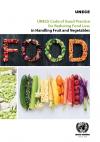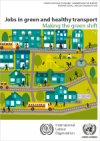Publications
Displaying Results 501 - 520 of 2840
- English
A Code of Good Practice which helps maintain quality along the fresh fruit and vegetables supply chains, to prevent and reduce food loss and waste. It sets out measures to be taken at the various stages of the supply chain before the fruit and vegetables reach the consumer, i.e. from harvest to retail and supports continued improvement, step by step. Real improvement, however, can only be
- Français
Il existe 59 instruments juridiques onusiens dans le domaine des transports intérieurs qui sont administrés par le Comité des Transports Intérieurs de la Commission Economique des Nations Unies pour l'Europe (CEE-ONU). Parmi les 59 conventions, sept instruments dans le domaine de la sécurité routière sont considérés comme des priorités pour l’adhésion:- 1968 Convention sur la circulation
- Español
Existen 59 instrumentos jurídicos de las Naciones Unidas en el ámbito del transporte terrestre que son administrados por la Comisión Económica de las Naciones Unidas para Europa (CEPE). De las 59 convenciones, siete instrumentos se consideran prioritarios en seguridad vial para la adhesión:- Convención de 1968 sobre la circulación vial;- Convención de 1968 sobre la señalización vial;- Acuerdo
- English
There are 59 United Nations legal instruments in the area of inland transport which are administered by the United Nations Economic Commission for Europe (UNECE). Of the 59 conventions, seven road safety instruments are considered to be priorities for accession:
- 1968 Convention on Road Traffic;
- 1968 Convention on Road Signs and Signals;
- 1958 Agreement concerning the Adoption of
- Pусский
Изложенные в настоящем документе руководящие принципы (далее «Руководящие принципы») направлены на оказание правительствам в регионе ЕЭК ООН поддержки в их усилиях по совершенствованию процесса разработки опирающейся на фактологические данные политики обеспечения устойчивости городского развития и жилищного хозяйства.
Настоящий документ служит практическим руководством для лиц,
- English
The guidelines aim to support the efforts of governments in the UNECE region to improve evidence-based policymaking on sustainable urban development and housing.
This document serves as a practical reference for policymakers and for other experts involved in the development, review and implementation of policies on sustainable housing and urban development. The Guidelines can be used at
- English
The idea of viewing human knowledge and abilities as an asset and to estimate its value is not new but has gained more prominence in recent years. ln 2016, the United Nations Economic Commission for Europe (UNECE) published the "Guide on Measuring Human Capital"with the objective of pursuing the conceptual development of human capital measurement and with a particular focus on developing
- English
This Guide contains a circular city implementation framework that is designed to improve circularity in cities and support stakeholders in implementing circular actions. The framework consists of a four-step methodology that provides a consistent method for assessing, prioritising and catalysing different circular actions. This deliverable is developed in response to the growing sustainability
- English
Organizations around the world are quickly adapting their programme and project activities to respond to the COVID-19 pandemic and its consequences. The UN Road Safety Fund is committed to the principles of adaptive programming, partnerships, and relevance. The operationalization of these principles is even more critical during this unparalleled time. This flyer provides tools and tips for
- English
The UNRSF 2019 Annual Report is now available. Established two years ago as an innovative United Nations pooled fund, the Annual Report showcases the first concrete results of the UNRSF and thus demonstrates its potential to meet its ambition to substantially reduce death and injuries from road crashes in low and middle-income countries where 93% of the world fatalities occur.
- English
This report presents a selection of examples of the impact of UNECE’s work in support of its member States for the implementation of the 2030 Agenda for Sustainable Development over the course of 2019.It shows how UNECE’s policy advice, practical norms and capacity building activities have helped countries and the people in the region.
- English
ECE/DP/83Overview of the State of Forests and Forest Management in Tajikistan derives from the project on the state of forests in the Caucasus and Central Asia and presents the forest resources and the forest sector of Tajikistan, including trends in, and pressures on forests. The overview describes policies and institutions of forest sector in Tajikistan and major challenges the sector faces
- English
ECE/DP/85Overview of the State of Forests and Forest Management in Uzbekistan derives from the project on the state of forests in the Caucasus and Central Asia and presents the forest resources and the forest sector of Uzbekistan, including trends in, and pressures on forests. The overview describes policies and institutions of forest sector in Uzbekistan and major challenges the sector faces
- English
ECE/DP/84Overview of the State of Forests and Forest Management in Turkmenistan derives from the project on the state of forests in the Caucasus and Central Asia and presents the forest resources and the forest sector of Turkmenistan, including trends in, and pressures on forests. The overview describes policies and institutions of forest sector in Turkmenistan and major challenges the sector
- English
ECE/DP/80Overview of the State of Forests and Forest Management in Georgia derives from the project on the state of forests in the Caucasus and Central Asia and presents the forest resources and the forest sector of Georgia, including trends in, and pressures on forests. The overview describes policies and institutions of forest sector in Georgia and major challenges the sector faces as well
- English
ECE/DP/79Overview of the State of Forests and Forest Management in Azerbaijan derives from the project on the state of forests in the Caucasus and Central Asia and presents the forest resources and the forest sector of Azerbaijan, including trends in, and pressures on forests. The overview describes policies and institutions of forest sector in Azerbaijan and major challenges the sector faces
- English
ECE/DP/81Overview of the State of Forests and Forest Management in Kazakhstan derives from the project on the state of forests in the Caucasus and Central Asia and presents the forest resources and the forest sector of Kazakhstan, including trends in, and pressures on forests. The overview describes policies and institutions of forest sector in Kazakhstan and major challenges the sector faces
- English
ECE/DP/82Overview of the State of Forests and Forest Management in Kyrgyzstan derives from the project on the state of forests in the Caucasus and Central Asia and presents the forest resources and the forest sector of Kyrgyzstan, including trends in, and pressures on forests. The overview describes policies and institutions of forest sector in Kyrgyzstan and major challenges the sector faces
- English
ECE/DP/78Overview of the State of Forests and Forest Management in Armenia derives from the project on the state of forests in the Caucasus and Central Asia and presents the forest resources and the forest sector of Armenia, including trends in, and pressures on forests. The overview describes policies and institutions of forest sector in Armenia and major challenges the sector faces as well
- English
This study, commissioned by the Steering Committee of the Transport, Health and Environment PanEuropean Programme (THE PEP) through its Partnership on Jobs in Green and Healthy Transport, examines the economy-wide employment implications of an accelerated shift towards greener land transport in the region of the United Nations Economic Commission for Europe (UNECE).
The study compares a ‘business







